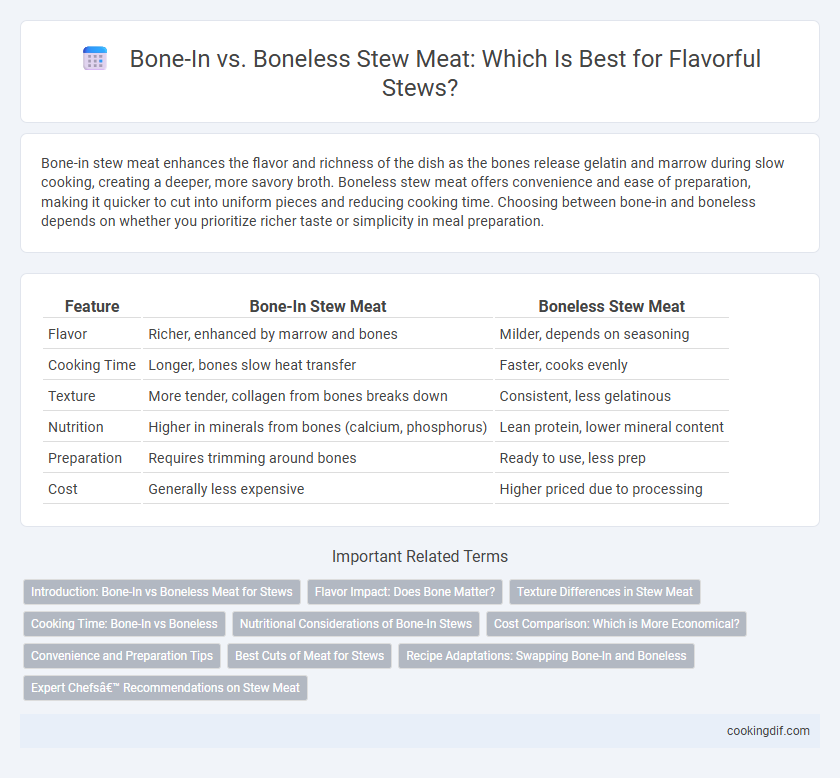Bone-in stew meat enhances the flavor and richness of the dish as the bones release gelatin and marrow during slow cooking, creating a deeper, more savory broth. Boneless stew meat offers convenience and ease of preparation, making it quicker to cut into uniform pieces and reducing cooking time. Choosing between bone-in and boneless depends on whether you prioritize richer taste or simplicity in meal preparation.
Table of Comparison
| Feature | Bone-In Stew Meat | Boneless Stew Meat |
|---|---|---|
| Flavor | Richer, enhanced by marrow and bones | Milder, depends on seasoning |
| Cooking Time | Longer, bones slow heat transfer | Faster, cooks evenly |
| Texture | More tender, collagen from bones breaks down | Consistent, less gelatinous |
| Nutrition | Higher in minerals from bones (calcium, phosphorus) | Lean protein, lower mineral content |
| Preparation | Requires trimming around bones | Ready to use, less prep |
| Cost | Generally less expensive | Higher priced due to processing |
Introduction: Bone-In vs Boneless Meat for Stews
Bone-in stew meat offers richer flavor and enhanced moisture retention due to marrow and collagen breaking down during slow cooking, creating a more gelatinous texture. Boneless meat delivers convenience and faster preparation but may lack the depth of taste and body that bones contribute. Selecting bone-in cuts like beef short ribs or lamb shoulder can elevate the stew's complexity and mouthfeel compared to boneless alternatives.
Flavor Impact: Does Bone Matter?
Bone-in stew meat infuses dishes with richer, deeper flavors as the marrow and connective tissues slowly break down during cooking, enhancing the overall taste profile. Boneless stew meat offers convenience and uniformity but lacks the subtle umami complexity contributed by the bone. Choosing bone-in meat elevates the stew's robustness, creating a more savory and satisfying experience.
Texture Differences in Stew Meat
Bone-in stew meat enhances texture by releasing collagen during slow cooking, resulting in a richer, gelatinous broth and tender chunks. Boneless stew meat offers a more uniform texture that cooks evenly but lacks the depth of mouthfeel provided by bones. Choosing bone-in cuts improves the overall hearty and satisfying consistency characteristic of traditional stews.
Cooking Time: Bone-In vs Boneless
Bone-in stew meat typically requires longer cooking times than boneless cuts due to the heat needing to penetrate the bone for thorough cooking. The bone helps retain moisture and adds flavor, but slow simmering or braising is essential to achieve tenderness. Boneless stew meat cooks faster and is ideal for recipes with shorter cooking durations, although it may lack the depth of flavor contributed by bones.
Nutritional Considerations of Bone-In Stews
Bone-in stew meat provides enhanced nutritional value by releasing minerals such as calcium, phosphorus, and collagen into the broth during slow cooking, enriching the stew with natural nutrients. The gelatin derived from bones aids in joint health and digestive benefits, making bone-in stews a nutrient-dense choice. Boneless cuts, while more convenient, lack these additional mineral and collagen benefits that contribute to overall nutritional quality in stews.
Cost Comparison: Which is More Economical?
Bone-in stew meat typically costs less per pound than boneless cuts due to the weight of the bone, offering better value when considering cooking yield. The presence of bones enhances flavor through marrow release during slow cooking, which can reduce the need for additional seasoning or broth, effectively lowering overall ingredient expenses. Boneless stew meat, while convenient and quicker to prepare, often carries a premium price and may require extra flavoring elements, making bone-in stew meat the more economical choice for budget-conscious cooks.
Convenience and Preparation Tips
Bone-in stew meat offers richer flavor and tenderness due to marrow and collagen but requires extra time for trimming and longer cooking to break down connective tissue. Boneless stew meat provides convenience with easier handling, faster cooking times, and simplified portioning, making it ideal for quick recipes or beginners. For optimal preparation, trim excess fat from bone-in cuts and soak boneless meat in marinade to enhance juiciness and tenderness.
Best Cuts of Meat for Stews
Bone-in cuts like short ribs and oxtail enhance stew flavor through marrow and gelatin release during slow cooking, creating richer, thicker broths. Boneless cuts such as chuck roast and round steak offer tender, easily shredded meat ideal for stew texture without the need to remove bones while eating. Choosing the best cuts depends on balancing taste depth from bone-in options and convenience from boneless pieces in hearty stew recipes.
Recipe Adaptations: Swapping Bone-In and Boneless
Swapping bone-in for boneless stew meat requires adjusting cooking times, as bone-in cuts add flavor but need longer simmering to tenderize the meat around the bone. Boneless stew meat cooks faster and is ideal for quicker recipes, but lacks the depth of richness that bones impart during slow cooking. Recipes should be adapted by reducing cooking time for boneless cuts or enhancing flavor with broth and seasonings when omitting bones.
Expert Chefs’ Recommendations on Stew Meat
Expert chefs recommend bone-in stew meat for richer flavor and enhanced tenderness during slow cooking, as the marrow and collagen break down, enriching the broth. Boneless stew meat offers convenience and faster preparation, but may lack the depth of taste and gelatinous texture that bones impart. Selecting bone-in cuts like short ribs or shanks yields a more robust and satisfying stew experience favored by culinary professionals.
Bone-in vs boneless for stew meat Infographic

 cookingdif.com
cookingdif.com